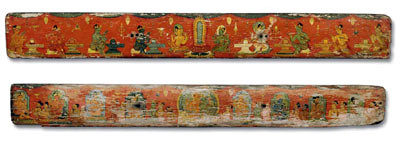One of them is a 12th century wood cover which is believed to be one of the oldest known painted art objects in Nepal
Four painted wood covers of palm-leaf manuscripts had been put up for auction to be sold at Christie’s on 19 March at New York’s Rockefeller Plaza. They were pulled out last week after objections from academics and specialists of Himalayan art.
Each of the four paintings was unmistakably identified as the property of the National Archive in Kathmandu, based on comparison with images in an inventory created by the Nepal German Manuscript Project in 1970.

NOT FOR SALE: The front cover (top) and back cover (below) of a 12th century manuscript that was stolen from the National Archive. One of the oldest known paintings from Nepal, Christie’s cancelled its auction last week after an outcry.
The rarest of the four works is a 12th century wood cover which is believed to be one of the oldest known painted art objects in Nepali history. It is the cover of a manuscript of the Shivadharmasangraha and depicts ascetics and deities across a red background. Shiva, Uma, and Nandi are at the centre, with other assorted deities worshipping linga-yoni and a jyotirlinga. It would have fetched anything up to $50,000.
The painting had previously been reported missing in a 2009 book on Hindu Miniature Paintings of the Kathmandu Valley by Savitri Mainali. The provenance provided by Christie’s on its website said the paintings belonged to a private collection, acquired in Paris in 1989-90.
In an email to Prof Jinah Kim of Harvard and Alexander von Rospatt of Berkeley, Sandhya Jain-Patel, head of sale at the Indian and SouthEast Asian Department of Christie’s wrote: ‘Since first learning this information on these Nepalese book covers we immediately conducted further investigation and based upon your help and information from our investigation, we decided in concert with our consignor that we will be withdrawing all four lots of Nepalese wooden book covers from the sale.’ She added that the collector has offered to cooperate to return the book covers to Nepal.
When asked to comment, the Director General of the Department of Archaeology, Bhesh Narayan Dahal told Nepali Times: “We have also received information about the auction and I have directed the National Archive to find out more.” Over at the National Archive, chief Prakash Darnal at first wanted to know how this paper found out about the theft. On the record he told us: “We don’t know exactly when it was stolen and we were also surprised to hear about it.”
Soon after the interview, Darnal shot off an email to Jain-Patel of Christie’s that asked her to provide the name and address of the collector. ‘We expect your and his/her full cooperation in speedily returning the objects to the National Archives.
Otherwise, we will have to take legal action and for that we will contact Interpol,’ Darnal threatened.
It is unclear how the case will proceed since there is no known record of when the pieces went missing, if the loss was documented, and whether or not a police report is available. An official claim by the police and subsequent request by Interpol to US authorities would likely begin the process of returning the stolen objects, experts say. However, there have been cases in the past in which foreign collectors have voluntarily returned stolen art.
Kunda Dixit
Read also:
Here today, in Europe tomorrow
Lost and found Buddha